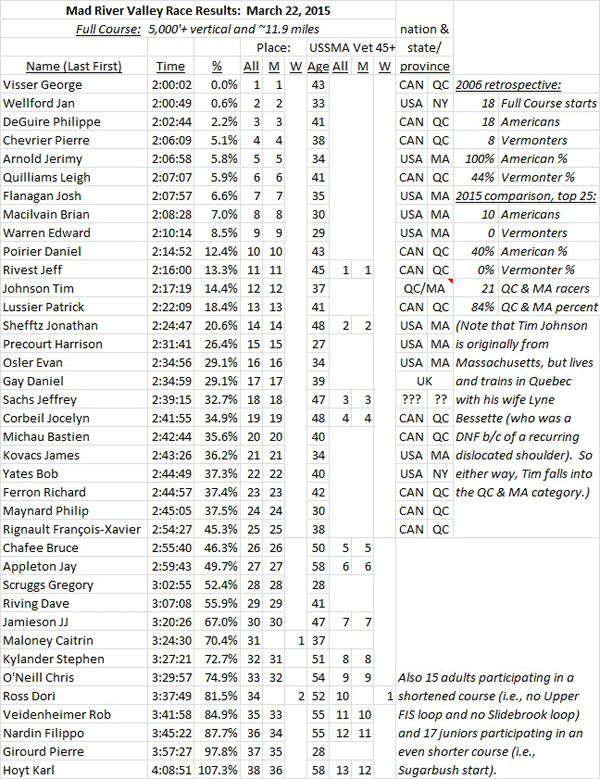Last year, we posted our picks for the best ski mountaineering trip reports from North America in the 2013/2014 season. We decided to do it again this year with the following criteria: a well written report with exciting photos and true ski mountaineering, not just ski touring.
While last year was marked by a series of exciting reports on FKTs in North America, this year that front was much quieter. Instead, we have a handful of cool trip reports to take your mind off the unbearable summer heat.
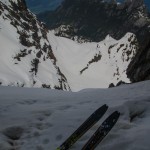
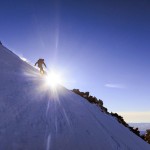
Next up is a report from our Utah friends, the Dorais brothers. Jason and Andy have been fixtures on the skimo racing podiums in the US and have also been stepping up their game in big mountain terrain. After returning from the Ski Mountaineering World Championships in Switzerland, along with Tom Goth, another top US skimo racer, they ticked off the Teton Trifecta in excellent style. A technically demanding series of descents, presented with words from Andy and excellent photos from the group here.
Also be sure to check out the recent film documenting the Dorais bro’s approach to life and skiing by Duct Tape Then Beer Productions at the end of this post.
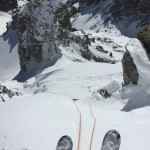
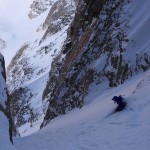
Another report is from Noah Howell, formerly of Powderwhore Productions, is well versed in story telling and generally an impressive photographer. While he may look a rather unlikely skimo racer, he seems to be one of the few who truly race for the fun of it. When he isn’t racing skinny skis on the North American series, he seems to have an affinity for getting a little further afield than most of us and embracing the suffering that accompanies such trips. His report from a spring trip to the Beartooth Mountains is illustrative of this approach to technical ski mountaineering descents.
Last up, not a specific trip report but a blog to follow for its beautiful pictures and excellent beta if you find yourself skiing in the Cooke City area, the Cook City Chronicle by Beau Fredlund.
And that should be enough reading to stoke the excitement for winter! 🙂
If you have any other awesome trip reports that you think must be included, link them in the comments below!
2015 Skimo Summer Training Camp
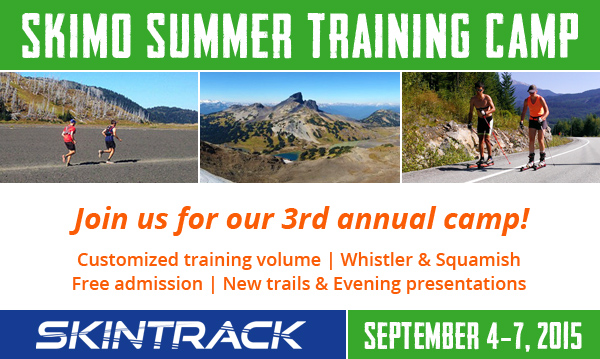
If you are reading this then you are invited 🙂
We have decided to change things a little with basing one or two days around Whistler and beyond. This will provide us with new trails and mountain objectives.
The camp will partly serve as the fall training camp for Canadian National Skimo Team but most importantly it will also be open to public.
Not a skier? No problem! This will be a trail running focused camp so trail, mountain, and ultra runners are encouraged to join us!
» Sign up for updates further down «
Quick overview
- Training for 3-4 days around Squamish and Whistler, BC with fellow skimo racers and members of the USA and Canadian national teams.
- Dates are September 4-7, 2015.
- Activities will mainly involve trail running, light mountaineering, with cycling, swimming and roller-skiing as options as well.
- Costs will be kept to minimum as we as organizers (Eric and Stano) are fully volunteering our time.
- Optional Vertical Mountain Running race at Whistler Blackcomb!
- We are really excited for our Escape Route evening presentation by the one and only Trevor Hunt!
- Couple of generous sponsors will keep us fueled, geared up and tired.
Sign up for updates
As we are finalizing the exact schedule, please sign up below to keep you updated.
* Also, include information such as:
- for which days you would like to join,
- which activities (running, roller skiing) you cannot participate in (cause of injury or don’t have gear),
- where are you coming from,
- and how fast can you run a beer mile 🙂
Logistics and Gear
The camp will officially begin Friday afternoon but we understand work schedules may prevent some from joining us then. Feel free to come Friday night or catch up with us Saturday morning.
Athletes are responsible for finding their own housing during the camp but we will do everything we can to help you find a place. If you have friends to stay with in town, great, if not, let us know and we will try to figure something out!
Here is a basic gear list for the camp:
- Running Shoes
- Training clothing
- Sandals, post workout clothing, and beach gear
- Ski/running poles
- Food for fuel during workouts
- Preferred snacks for meals
- Helmet
- Roller-skis (optional)
- Mountain or road bike (optional)
- Rock climbing gear (optional)
Can I handle it? You should be able to complete 3 days of endurance exercise, with up to 2-3h of running per day in order to attend. Most of our long runs have extended periods of hiking involved so are not as intense as they may sound. If you are unsure if you should attend send us an email!
» Here is how the the first Canadian Team summer training camp in Squamish went two year’s ago.
» Here is how a Canadian Team summer training camp looked like in Revelstoke in 2012.
» To improve your training in the meantime checkout these:
- Our Skimo Racing Manual e-book
- Summer training tips for skimo racers from Adam Campbell (professional mountain runner)
- “Bread and butter” summer training for rando racing…
- Hiko-run: Skimo racer’s best summer friend
20 Questions for Stevie Kremer: Training, Racing, Plans
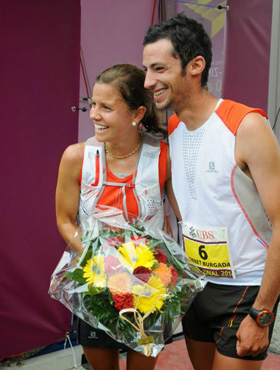
Stevie’s racing outfit changes as seasons pass and her ever present smile and white pearl earrings can easily fool anyone into thinking that she’s not a force to be reckoned with. In reality though, they will quickly be surprised.
After somehow not having interviewed Stevie yet, I emailed her with a request just as she was packing for a trip. She kindly agreed, so we are all fortunate to have her share some of her training methods and thoughts on life as a working pro.
Enter Stevie Kremer
Q: Summer is here and you are back to trail running racing. How was your recent trip for a Sky Ultra to Madeira?
My time in Portugal was incredible! Madeira is absolutely beautiful and the people are so friendly and welcoming. As for the terrain and trails – they are insane! Technical, steep, yet fun and adventurous!
Q: What are your goals for 2015?
I would like to continue to travel and compete in new mountain races around the World.
Q: Every winter, you compete in a number of skimo races but mostly in the US. As fast as you are, aren’t you attracted to compete in Europe?
I would love to compete more in Europe, but because of my work schedule, it is difficult to travel that far. If I can make it work, I definitely would, and will!
Q: How long have you been trail running and ski mountaineering? What attracted you to start racing as well?
I have been competitively running for about 4 years now. Although I competed in some smaller mountain and trail races a few years prior to that, I didn’t get really competitive until the summer of 2011. In regards to ski mountaineering, I have been competing for 5 years.
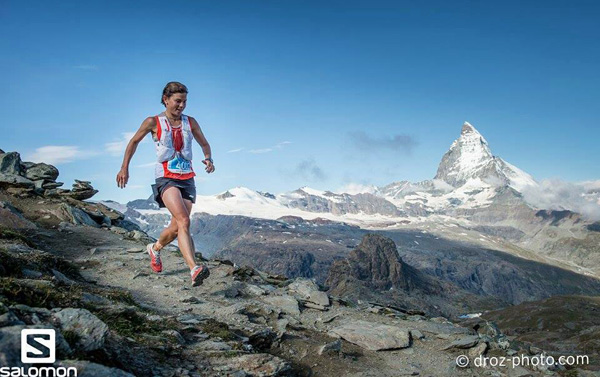
Q: You are a teacher but also a Salomon Team athlete. What else defines you? What else would you like to try or do in the future?
Honestly, I would like to continue running and skiing forever 😉 But in between, I would really like to introduce a family to this world 🙂
Q: Today, the North American trail community appears to be obsessed with ultras, the longer the better. You seem to prefer Skyrunning and mountain running races over other the longer events. Is it because you like more technical trails or because racing 10+ hours does not appeal to you as much?
I do not like running more than 5 hours! I will compete in something around 6h if it’s an appealing course (not too much technical downhill 😉 ) but typically 4-5 hours is the maximum I like to run!
Q: Do you have any plans to run in one of the iconic ultras at some point, like Western States 100 or Hard Rock 100?
I have so much respect for those athletes running these incredible distances and times, but I have no desire to ever do one.
Q: You won the overall Skyrunner series titles in 2013 and 2014, and a combined title at the 2014 Skyrunning World Championships in Chamonix. Did you live in Europe during those two seasons or were you mostly “commuting” from Colorado?
I lived in Europe (Italy) for the 2012-2013 year to teach at an International school, and moved back to Colorado in August of 2013. I have traveled for races since then, but have lived in Colorado.
Training
Q: Do you have a coach?
No
Q: Do you follow a strict training schedule or do you “freestyle” mostly?
I “freestyle” mostly. I just love to run on trails in the mountains, and I think if I had a schedule I wouldn’t enjoy it as much. Don’t get me wrong, there is some routine to my running, for example I run every morning before school at 5:00 am, but I never know exactly what I will be running, etc.
Here is a short 5min video about Stevie’s life and how she spend’s her days.
Interview continues below.
Q: Do you train with a heart-rate monitor or by feel?
By feel.
Q: How does your summer training month looks like? What kind of sessions do you do? How many hours in total?
A typical “work day” for me is to get up a little bit before 5:00 am, go for about an hour run, I am back by 6:15. Then I get ready for teaching and I am at work (school) at 7:15 am. School ends around 4:00 pm, so I’m typically back on the trails by 4:30 pm until about 5:30/6:00 pm.
Q: Do you run year-round or do you fully switch to skis for couple of months like Kilian Jornet usually does?
For the most part, I switch sports when the snow starts falling. But I am never 100% done with running. In the winter months, I probably run 2 hours per week, not more.
Q: Do you run your high intensity interval sessions on smooth surfaces and non-technical trails so you can go full gas the whole interval, or do you run them on technical trails like you encounter in Skyraces?
I don’t do much high intensity stuff, but when I do, I incorporate them on the trails. I’ll set out for a typical trail run and in between add some speed work for a few minutes.
Q: How do you practice downhills? Obviously you run down, but do you just continuously run or do you break it up into shorter intervals at maximum speed, with breaks in between?
No, but I should DEFINITELY do more speed work on the downhill!
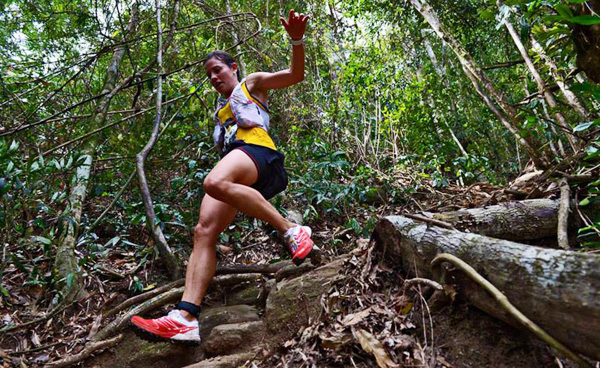
Q: What other sports do you practice besides running and ski mountaineering?
I like to play tennis and golf 🙂 And in the winter, I like to downhill ski too!
Q: Do you focus any part of the year on strength training? If yes, what kind of exercises do you focus on?
No, but I should work more on my arms and my core. I try to do something once a week, but it doesn’t always happen.
Q: For recovery, do you frequently seek a massage? How much do you sleep?
No, I never get massages. I try to sleep about 7 hours per night.
Q: Do you follow any distinctive diet – vegan, paleo, vegetarian, KFC…?
No, I try to eat healthy though.
Q: What mistakes did you do at the beginning when you started training? What should others pay attention to?
I think the most important thing to do in training (something I need to do more of) is speed work. Speed work is so essential to becoming a faster runner, I think at least 🙂
Thank you
Thank you very much to Stevie for taking time to provide us with answers and I hope you enjoyed it as much as me.
Mount Marathon 2015 Race Preview
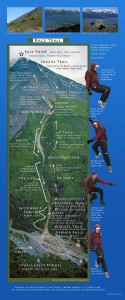
In 2013, the Mount Marathon garnered significant attention as the course record, set by Bill Spencer 32 years prior, was smashed by Alaska local Eric Strabel. Strabel, the head Nordic Ski Coach at APU, trained specifically for the race, both in terms of his fitness and sussing out the best possible course. Unique to the Mount Marathon are the course rules which essentially state that, aside from starting and finishing at the line, you must just run around the rock at the top of the course, choosing your own line as you go. With racers picking their own line through small cliff bands and down scree, this absolutely has an effect on the outcome of the race, especially on the descent.
Also of note in 2013 was the second place finisher, American ultra runner Rickey Gates. Gates actually led the race by a small margin until Strabel was able to overtake him on the descent (during which Gates fell and dislocated his shoulder see video linked at the bottom). Strabel out sprinted Gates who finished 2nd, also ahead of Spencer’s 1981 course record.
In 2014 both Gates and Strabel returned to the race for a rematch. Strabel again won with Gates finishing in 4th. As the notoriety of the race increases, bigger names will continue to show up and with the 2015 running, Seward will have the biggest name of all in attendance – Kilian Jornet! Jornet (ESP) is widely considered the best mountain runner in the world and is sure to do well at the Mount Marathon. Not only does he have one of the best engines in the world – routinely on top of skimo and sky running podiums – but also with a fantastic ability to run technical descents, a critical component of the Mount Marathon (See this shot of Jornet descending the Matterhorn – not 100% applicable but impressive nonetheless). The big question is: can Jornet knock Strabel off the top of the podium and set a new record time?
First looking at the uphill. The ascent requires approximately 33 minutes for the 880 meters of elevation gain. This is comparable time-wise to a vertical kilometre but is obviously less gain. It also includes a section of flat road at the beginning (for a total distance of 2.49 kilometres). The approximate grade of the climbing portion of the race is a fairly steep 35%! I’ll compare this to the vertical kilometre course in Chamonix which has an average grade of 26% for 1000 meters of gain. An interesting side note: the VK world record set in Fully, Switzerland by Urban Zemmer, is an amazing 1960 VAM! Fully is considered to be the most ideal VK course in the world with a direct ascent at a steady (and ideal) grade. VK racers also frequently use poles to ascend even faster.
Strabel’s fastest Mount Marathon ascent was 33.7 minutes. Because times between events like this are difficult to compare, it is easier to use a metric borrowed from cycling called VAM which is an estimation of ascent speed. Note the units are not m/sec but and arbitrary unit (VAM). Strabel’s ascent was at a mean VAM of 1567. Compare this to Jornet’s time of 34.9 minutes on the Chamonix VK climbing at a mean VAM of 1720. Significantly faster and with 120 additional meters of elevation gain. One thing to consider however is that the footing of most VK races (including in Chamonix) is significantly better than that of the Mount Marathon. Ascending well defined and groomed footpaths is much easier than loose scree. This certainly accounts for some loss in climbing speed.
Given Jornet’s fitness and the fact that he is regularly competing with and winning against the best athletes in the world, I would be hard pressed to bet against him being easily able to ascend the peak faster than anyone else. That being said, he may opt to race alongside the local athletes in order to follow their best line of descent back to the base and drop them once past any major technical difficulties. With such a short race however, (Strabel’s record descent is just over 11 minutes!) any small mistake could cause this strategy to backfire. A trip or fall like Ricky Gates’ in 2013 could jeopardize the race.
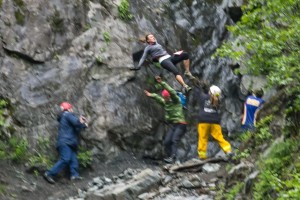
Besides SkinTrack’s general interest in mountain athletics, we are personally invested in this years Mount Marathon because one of the contenders is Squamish local and leader of the 2014-15 Canadian Ski Mountaineering National Team, Nick Elson! Nick applied for and was granted special permission to enter this year’s race and will be traveling to Seward shortly to start familiarizing himself with the course.
After chasing Jornet throughout the skimo season in Europe, Nick is familiar with his fitness and likely realizes that Jornet on top form will be unbeatable on the ascent. The top Alaskans however are certainly in Nick’s sights. If we look at the 2013 Grouse Grind race in which Nick placed third, the course tackles 853 meters of elevation with an average grade of 28% which is much closer to the Mount Marathon (by the numbers, the trace itself however is still very well defined- mostly stairs). Nick ran a mean VAM of 1786 – higher than Strabel’s 1567 VAM on Mount Marathon. We must also take into account the flat at the start of the Mount Marathon which reduces the VAM.
It is hard to compare performances on the descent as much of the Mount Marathon course features scree that can be almost skied down. Strabel’s amazing 11.01 minute descent has a VAM of -4795! Nick is well known as one of the strongest descenders in Canada and it will be interesting to see how he stacks up on the scree. In my opinion, Nick certainly has the potential to perform as one of the top three North Americans in the race. We caught up with Nick in the week leading up to the race.
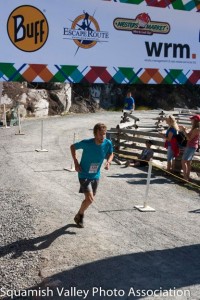
Nick: I’ve been trying to train as much as possible on the steepest trails around Squamish. To prepare for the climb, I’ve been doing some hard workouts on terrain where I’m forced to power-hike. For the descent, I’ve been doing some faster downhill running although I always try to stay in control enough that I don’t fall and hurt myself and also don’t get so sore that I can’t train the next day.
Skintrack: The descent is pretty daunting. Have you been training specifically for that and do you have any strategies?
Nick: I think that the descent is a big part of what makes the race so exciting. The upper portion is on loose scree which appears to allow you to reach pretty high speeds.
Lower down it gets more technical and there are a few options including “the cliffs” and “the falls”.
The fact that there are no course markings and you can choose your own route definitely adds an interesting tactical element to the race (and explains how a runner disappeared and was never found during the 2012 race). I’ll have three days prior to the race to preview the course and hopefully find the best route for me personally. I’m definitely a bit nervous because I know that to be competitive in such a strong field I’m going to have to take some chances on the descent.
Skintrack: What are you looking forward to most about the race and finally what plans do you have for racing the rest of the summer?
Nick: I’m looking forward to the whole scene surrounding the race. This will be my fifth time in Alaska so I think I have an idea of what to expect. However, I think the whole experience will be a little bit crazy. After the Mt. Marathon race, I plan on running the NACAC/Canadian Mountain Running Championships at Cypress on July 18th. Then I’ll try to shift my focus to longer distances in the lead-up to the Squamish 50.
Not to leave out the women, recent years have not seen heavy competition. The female course record was set in 1990 by Nancy Pease in a time of 50.5 minutes (which would have earned her 11th place in the 2014 mens race) and stands fairly uncontested. Olympian Holly Brooks gave several serious stabs at the record but struggled with difficulties in the heat. Something that could be a major factor in this year’s race. 2015 is likely to be dominated by sky and ultra running superstar Emelie Forsberg. Forsberg (SWE) is attending the race for the first time but routinely dominates anything she enters. My bets are hands down on Emelie for the win.
Follow the race live here!
Mt Marathon:
880m Ascent
35% Grade
33.68 min (Eric Strabel) 1567 VAM
Downhill: 11.01 min
Overal Record: 42.92
Female – Nancy Pease (1990) 50.5 min (11th place in 2014 Men’s Race)
Chamonix VK:
1000m
26%
34.88 min (Killian Jornet) 1720 VAM
VK RECORD:
Fully Switzerland
1000m
30.6 min (Urban Zemmer) 1960 VAM
Grouse Grind:
853m
28%
26.38 min (Joe Grey) 1940 VAM
28.6 min (Nick Elson) 1786 VAM
Calculations:
VAM = (vertical ascent in meters X 60) / minutes
Trofeo Mezzalama update: Eric Carter's team placed 13th while Italians won
Here is a quick update I got Eric today after they finished Mezzalama. Photos are coming.
The race went off despite only a 10h weather window between storms which the organizers nailed perfectly. Mezzalama lived up to its reputation of atrocious weather with 80+kph winds in the alpine – difficult to stand/move at times. We skied much of the race in puff jackets and warm-up pants. Sun came out though and the course was run in full.
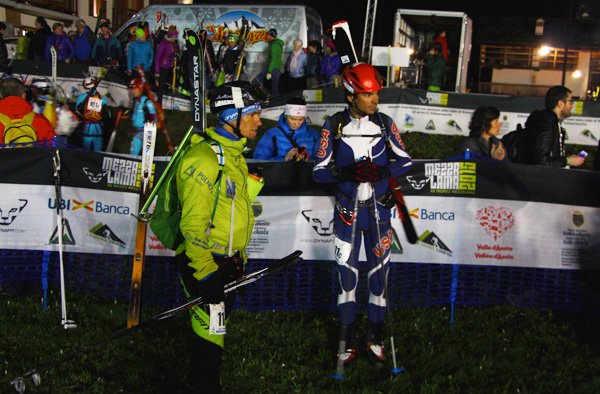
Team Italy 1 (Matteo Eydallin, Michele Boscacci, Damiano Lenzi) lead from the start with Team Italy 2 (Robert Antonioli, Lorenzo Holzknecht, Manfred Reichegger) pushing close behind until they pulled away for good mid-race. Anton Palzer’s team finished in third only 17sec behind. The Italians seem to have this race dialed in every way possible.
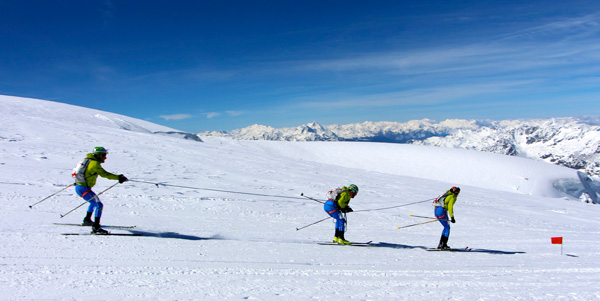
» Full results from 2015 Mezzalama
Our race
Pascal Egli (SWI) and I lost Lars Erik (SWE), our original teammate, because of the change of date but took on a young Slovak Peter Volnar. He hammered along without complaint on the ups and led our rope on the descents. We made some minor technical and clothing errors but raced a smooth race overall.
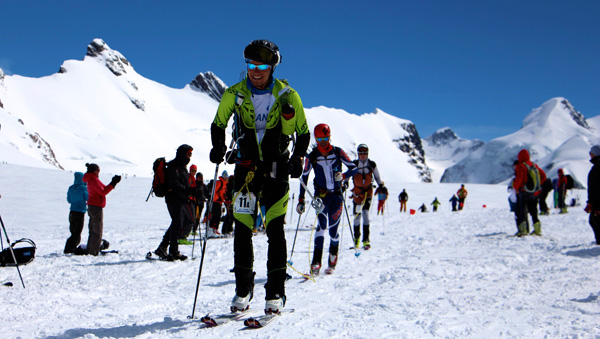
Here is Eric summing up his experienced right after crossing the line:
Now we drive back to Chamonix and pack up and tomorrow morning fly back to Canada! Fucking awesome way to cap a spectacular season. 🙂
Congrats boys! And chapeau to a superb season Eric!
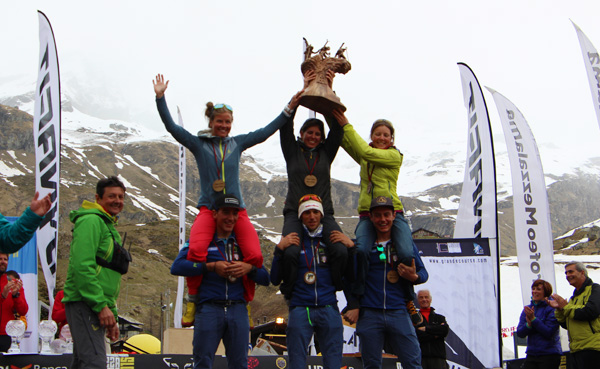
Catching up with Eric Carter before Trofeo Mezzalama
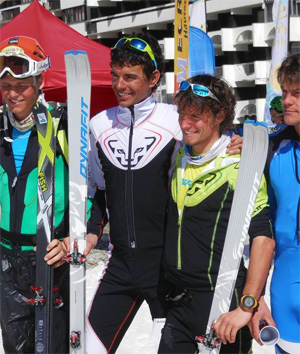
Coming off a successful Pierra Menta with Nick Elson, he will be partnering for Mezzalama with our Swiss friend Pascal Egli, with the third teammate still to be determined.
Eric and Pascal managed to win a 2-day Ski Ecrins skimo race in France two weekends ago!
Q: After placing 15th at Pierra Menta and winning the Ski Ecrins 2-day teams race how do you feel about Mezzalama? Who are your teammates?
Lars Erik and Pascal were supposed to be the team but due to postponing Lars Erik has to go back to Norway and can’t stay, so if anyone knows of someone looking for a team please let us know!
I think we have a good shot at a decent placing in Mezzalama depending on who jumps in as our third. We were assigned bib #11 which might be a good sign 🙂
Regardless, as long as we don’t have any equipment, illness, or crash issues and just ski smoothly, I’m sure we will be quite happy with our race.
Q: How was your April in Chamonix? What did you get up to?
Since Mezallama got postponed, Lars Erik and I took advantage of the good conditions in Chamonix for a rip up and down Mont Blanc last week. Not particularly fast since it was beautiful and we couldn’t stop taking photos! I felt good at the altitude though and am feeling the most acclimatized of my life!
Since the last World Cup, I’ve been skiing but summer has arrived in full force in Chamonix, so I’ve spent quite a bit more time taking the lift up high and doing some fun and easy alpine climbing which is a nice change.
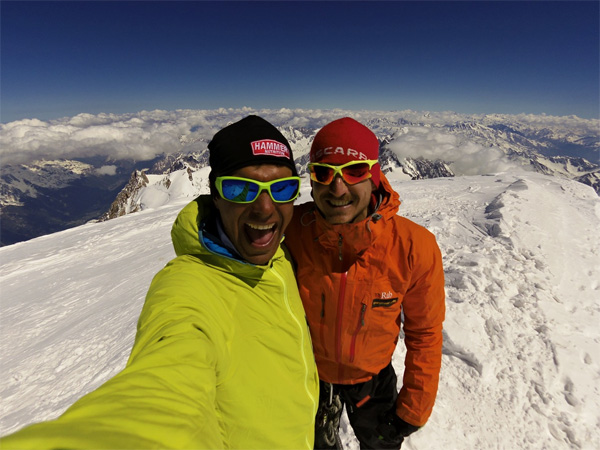
I will be getting back right after Mezzalama, and I’m really looking forward to getting back to Squamish to see everyone and jump into BC summer.
I’ve got some running plans and want to do lots of rock climbing but nothing set in stone. For running races, I won’t do an ultra this season but a few others: Sea to Summit race at the S2SG, Kusam Klimb, Broken Goat VK, Survival of the Fittest, Comfortably Numb, Grouse Grind Race, and perhaps some more.
Transitioning from Skimo to Summer Training
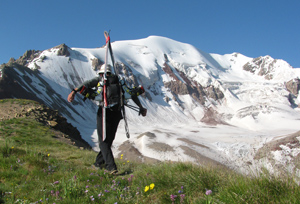 Spring arrives at different time in different years. Some of us finish the last race of the season in February or March and are ready to hang up the skis. Others, with sufficient snow or motivation, are able to push the ski season well into May or even beyond.
Spring arrives at different time in different years. Some of us finish the last race of the season in February or March and are ready to hang up the skis. Others, with sufficient snow or motivation, are able to push the ski season well into May or even beyond.
Regardless, at some point most of us have to pack the skis away for the summer and switch to dryland training.
In this article, we want to provide you with a some tips and cover a couple of key things to keep in mind when you switch to summer training.
Equipment
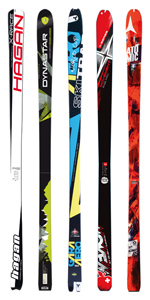 Make sure to take take care of your equipment:
Make sure to take take care of your equipment:
- Put a layer of warm (yellow or white) storage wax on your skis and leave them un-scraped. This will prevent the bases from oxidizing over the summer.
- Remove the batteries from your beacon and store it properly with the battery compartment open (so if you do grab it, you will remember to put new ones in).
- Wax your skins and apply them to a glue-saver plastic backing for long term storage.
- Make a list of gear that needs to be replaced or repaired and take advantage of end of the season sales. Three specialized skimo stores we recommend are:
- Skimo.co – http://skimo.co/
- Cripple Creek BC – http://www.cripplecreekbc.com/
- Boulder Nordic Sports – https://www.bouldernordicsport.com/shop/c-377-alpine-touring.aspx
Transition Gently
Skimo racers are all about fast transitions but it is never a good idea to immediately jump right into training for another sport.
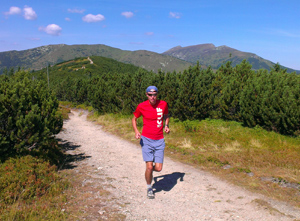 Most of us are runners or cyclists in the summer and it may be tempting on your first run or ride to try to hit the same volume as when you ended the previous summer.
Most of us are runners or cyclists in the summer and it may be tempting on your first run or ride to try to hit the same volume as when you ended the previous summer.
In an ideal scenario, as the ski season is winding down, you will start to mix in a few easy runs and rides throughout the week to fill in as the ski days dwindle. This is the best way to ease into your new season and to avoid injury.
Take Downtime of 2-3 weeks
While ski touring does not have the high-impact component that running does, it is still hard on our bodies in a different way. With running, it is likely that an athlete will experience musculoskeletal injuries or at least will feel sufficiently beat up to take some rest. Skimo athletes, due to the nature of the sport, are less likely to experience such injuries or symptoms, therefore, are able to push their bodies further towards overall fatigue and overtraining. Because of this, it is especially important to take several weeks of rest at the end of your ski season.
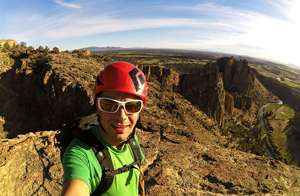 During downtime, we advise athletes to ‘move’ but don’t ‘train’. Fun, easy runs and rides are good if your body feels up to it but even better is to get out and enjoy nature in a different way for a little while – rock climb, paddle, or just hike. Once your mandatory two weeks have passed, consider a third based on how you feel.
During downtime, we advise athletes to ‘move’ but don’t ‘train’. Fun, easy runs and rides are good if your body feels up to it but even better is to get out and enjoy nature in a different way for a little while – rock climb, paddle, or just hike. Once your mandatory two weeks have passed, consider a third based on how you feel.
Downtime is also important for mental well-being. At the end of the season, most of us are pretty tired of ’training’. Time away from your (racing) sport will allow you to remember why you love them, and by the end of your rest period you should be itching to get back on your bike or lace up your shoes! If not, reevaluate your situation and perhaps seek an experienced coach to help you out
Write your Annual Training Plan!
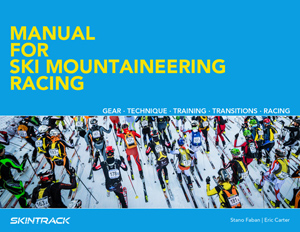 With the spare time you will have in your downtime block, it is the perfect time to develop your Annual Training Plan (ATP). This process is detailed in SkinTrack Manual for Ski Mountaineering Racing so take a look there for more information.
With the spare time you will have in your downtime block, it is the perfect time to develop your Annual Training Plan (ATP). This process is detailed in SkinTrack Manual for Ski Mountaineering Racing so take a look there for more information.
By planning your next season during the rest period, you give yourself the benefit of an entire year to prepare rather than deciding things in a rush as you go.
Keys points for creating your summer training plan:
- Long slow distance training is the key to developing a successful base for ski mountaineering. The mode (running or cycling) is less important but the hours are.
- Mountain running should be used instead of flat running whenever possible to help maintain muscle strength necessary for climbing and downhill skiing.
- Choose a summer race schedule that complements your skimo training. This means races of similar duration and terrain (1-3 hours with significant vertical gain and descent). While ultra-marathons may be the sexy events of trail running right now, they are not the ideal way of preparation for skimo racing for most of us.
- Stano and I personally find it difficult to get in the strength room at the beginning of the summer. It is just too nice outside to “waste energy” inside. That being said, strength is an important component. Plan to start strength training mid-summer and continue through the fall and early winter.
- Take time for some adventures. Just like during the winter, it is important to get away from racing and explore the backyard. Plan some long days in the mountains to practice your technical skills and endurance, and you will see the benefits when winter returns.
Takeaway Points
- Deal with gear issues and store it properly.
- Take two to three weeks downtime with no ‘training’.
- Plan your summer and next season.
- Train hard and wise – make the summer count!
Review of CEP Compression Progressive+ Ski Merino Socks: Great for ski touring
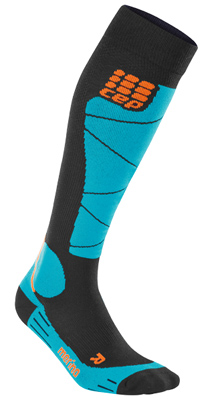 Quick overview:
Quick overview:
- Usual full price: about $69.00 CAD
- Weight: about 90 g / pair
- Pros: Fit, Function, Comfort, Odor free
- Cons: Slightly warm on warm days
- Suitability: Ski touring, skimo racing, downhill skiing
Bottom line:
Very functional and a very well manufactured piece of gear, little not to like.
Product description and How we tested it:
CEP Compression is known for being one of the best (if not the best) manufacturers of compression products in the world. History of this German brand dates back a couple of decades and quality of their experience comes from healthcare compression garments manufacturing.
CEP describes these Progressive Merino socks as having “clever combination of merino wool and water-repellent synthetic fibers for perfect heat and moisture management” which I found very true, except, my calves felt a bit too warm when I ski toured in them in balmy weather (above zero Celsius) we had this February and March. For such weather, I prefer a much lower or a thinner sock.
As for compression, CEP claims optimum performance and recovery, stability for muscles and joints, and improved coordination. Before trying out these socks, I tried another two brands (Asics and Dynafit) which made me skeptical about the whole compression for performance thing. I do feel (and I believe) that compression socks help me with recovery, especially, if I need to sit or stand for longer periods of time after a hard workout. However, the performance benefit was always lost on me as I never felt comfortable with the pressure around my calves while skiing or running, it felt like too much after about 2h of touring.
The CEP ski socks feel way more comfortable than the other two I tried and my calves feel fresher afterwards, but I cannot say the compression is “helping” or “optimizing” my performance. I would define it more like this – if my feet, shins and calves feel comfortable, dry and happy even after 6-7 hours of ski touring in various conditions then I do like such socks a lot.
Another detail that I think makes these socks great are padded zones or panels that are definitely at the right places, and the fact that they are all blended together with flat seams, thus, providing a nice fit.
Important: As with any other compression garments, make sure to choose the right size for you as that will greatly impact your experience. CEP provides sizing charts on their websites so you won’t have any problems with that.
Pros:
- Everything a ski sock should be.
- Heat and moisture management.
- Fit and comfort.
- The socks are quite odor-free even after 2-3 days of continuous use.
Cons / What can be improved about this product:
- If your lower leg never really gets cold then these might be a bit too warm for you for spring touring (around and above zero Celsius).
Product Specs:
- Materials: 67% polyamide, 23% wool (merino), 10% spandex
- Sizing: Men’s, Women’s, sizes 2-5
Online stores that carry CEP Compression Ski Socks:
- $69.99 CAD from CEPcompression.ca (skiing thermo socks model)
- $69.99 CAD from CEPcompression.ca (race skiing socks)
- $65.00 USD from CEPcempression.com (the reviewed model)
Jeannie Wall interview: North America’s Skimo Pioneers Series
This is a second 5-question interview with someone that can be considered as one of North America’s skimo pioneers.
» The first one in this series was an interview with Andrew McLean.
» Interview series archive – North America’s Skimo Pioneers Series.
Series supporters:
This interview series is presented by Skimo.co and Cripple Creek Backcountry.

5 Questions for Jeannie Wall
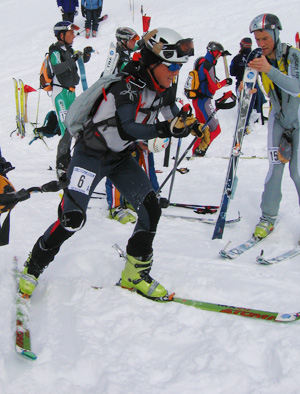
- Jeannie raced skimo between 2002 and 2006,
- she placed 5th at the 2004 World Championships in a vertical race,
- finished 4th at the 2005 Pierra Menta,
- and she won won the famous American Birkebeiner cross-country ski race in 2002
Q1: Jeannie, what is your sporting/racing and outdoor activities background?
Team sports through high school, then triathlons, Nordic racing, ultra running racing, some bike racing, intermittent climbing and bc and resort skiing. Ran around the woods, lake and hood as a kid. I had a lot of energy 🙂
Q2: When and why did you decide to give skimo racing a serious shot? What did you think of the sport at that time?
After I missed the US Olympic Nordic Team in ‘02, I went on to win the overall women’s title at the 2002 American Birkebeiner Nordic ski race, which was a dream. But I was tired of Nordic and its politics and not being in the mountains. I loved downhill skiing, the mountains, and climbing, so right after the Birkie, I jumped into the Jackson Hole Nationals Rando race.
I already knew I loved the sport as I had done an overnight skimo race in mid 90’s in Sweden, the Kebnekaisa Classic 2-day race. As a team of 3 women, we dug and slept in a snow cave, it was crazy stormy out. The wind was howling and everyone was digging bivy caves into this snow burm, and we felt like a chain gang. I absolutely loved it, but we had no races like that back in the US at the time so I pursued Nordic racing.
Then in 2002, we started having more US rando races and the combo of uphill/downhill/endurance and other skills opened up a new world to me that was so much more fun, interesting and challenging for me than Nordic. I was hooked after Jackson.
Q3: Can you list a couple of your biggest accomplishments in skimo, in other sports and/or in the mountains?
Nordic:
I went to the Olympic Trials in Alaska when I was 26 having done only 5 nordic races in my life, and no coaching, I knew nothing really, just loved to ski and did a lot of it. I ended up getting two 6th place finishes and missed the Olympic team by one slot. There was a big article in the local paper on me. It was thrilling as I had no expectations. But my biggest reality check on politics came with it. I was told I was “too old” for the US Nordic team.
I decided not to give up my day job and went on to win most skate marathons in the country, but was forever deflated to not have a chance to get some US team coaching and race for the US in those years just after that. I lost all respect for the US Ski Team administration after I saw them do the same thing to many of my fellow racers and friends.
Skimo:
Racing the Pierra Menta with Emma Roca was all time high, not because we had a good race, but because I learned so much more about what a partnership in racing could and should be. She taught me so much about the give and take, it’s part of why I’m now so taken with climbing. Honestly, it is exhilarating to win races, but the experience of skimo that endures with me are the people I met and skied with, it was the richest and most fun group of passionate people I can imagine and I feel so lucky to have been part of it all and their lives.
Being in the top 3-to-5 with the men in most US rando races, and winning the women’s was great, but as we know, it was a very small field at the time. I’m so glad it’s growing. Being in the top 5 in my first world cup race in Andorra was super inspiring as I had no idea where I stood and was terrified. It was the same with being in the top 5 of the World Championship uphill race. I had frustratingly slow skins, but to be up there with the top women in Europe was so fun and inspiring.
I think the biggest accomplishment I can take from my skimo racing is to have learned from Emma, to have learned that’s it not about winning or losing, it’s how you play the game, it’s how you support your partners and others with you in the mountains, no matter what. With climbing that can mean life or death. With racing, it is a matter of integrity, meaning and the richness of life and races. If someday, I can say I really understand and live accordingly, I’ll have accomplished something meaningful. Otherwise, it’s just another race.
[For more details on North American skimo history see our Manual for Ski Mountaineering e-book.]
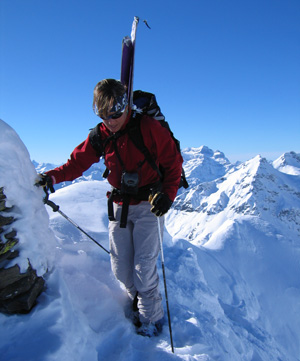
Climbing in the mountains both alpine and rock with great partners. Backcountry and ski mountaineering with great friends I trust and enjoy, waking in my Westy Bus with my guy and a fresh cup o’ jo, that’s where I find much of my joy and sustenance.
Q5: With years of experience from multiple sports, what would be the two most important pieces of advice you would give to new comers into skimo?
Find a fun partner and do a team race! Go suffer on skinny race skis downhill as much as you can. Go to Europe and race and meet all the amazing people in and around the sport.
Beyond
Keep checking back and follow SkinTrack on Facebook, Twitter, or subscribe on YouTube.
Northeastern U.S. Rando Action: Final Two Weekends of March
This report was submitted by our SkinTrack corespondent Jonathan Shefftz who is also the driving force behind the East Coast skimo series.
After kicking off the Northeastern U.S. skimo season at Berkshire East MA on January 24:
http://www.skintrack.com/skimo-racing/reports-results/report-berkshire-east-rando-race-2015/
… followed by five more races in February and March throughout Western Massachusetts and Vermont:
Stano’s note: somehow forgot to post but will get back to it. My apologies.
… the season wrapped up with three races in Vermont during the last two weekends of March.
Bromley, VT skimo race
On Saturday March 21, the NE Rando Race Series returned to its traditional venue of Bromley VT, expecting the traditional big soft moguls on the south-facing terrain. Unfortunately, during all the usual hectic pre-race planning and coordination, we forgot to notify Mother Nature that spring traditionally starts by that weekend.
The early-morning flagging of the descent route down the horribly refrozen moguls made for some doubtful moments, and the first race descent was rather jarring, both physically and psychologically. But fortunately the sun started to peek through for the next two descents, rendering the skiing conditions still challenging yet asymptotically approaching enjoyable. (A fourth full descent was curtailed because of possible rain showers later in the morning, a possibility that did not come true . . .but which of course would have had we not cut short the course layout!)
Competitively, a group of four charged out ahead on the first lap in a 2×2 formation so perfectly arrayed that it looked like a deliberate attempt at some new sport of syncro skinning. I was close enough on the second lap to see the formation still perfectly arrayed, and eventually all four finished within 52 seconds of each other: a Team Hagan potential podium sweep of Jerimy Arnold, Josh Flanagan, and Brian MacIlvain broken up only by U.K. national team member Daniel Gay snagging the last podium spot.
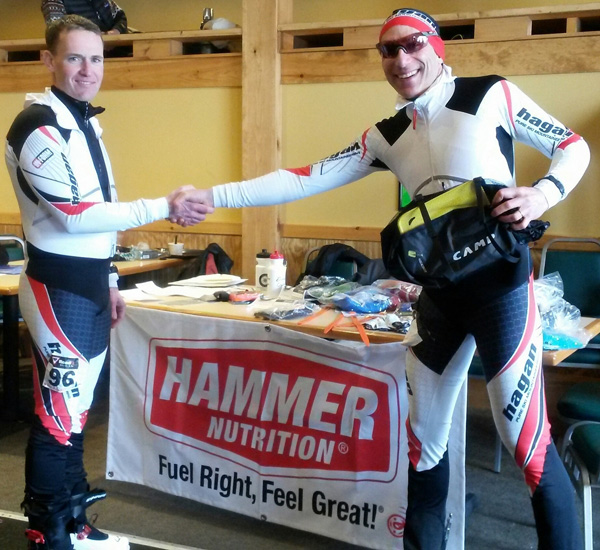
Further back, we had record participation for the Bromley venue, almost 75 percent more than last year, which in turn had been a near-record year.
After the race, Team Hagan rented a house for the night, joined by U.K. Dan and Denali Ed (i.e., the FKT before Kilian’s new record last year). Activities including eating, sleeping, gear preparation, trying to avoid mixing up all our nearly identical gear, and trying to figure out car shuttle logistics for complicated course layout the following day.
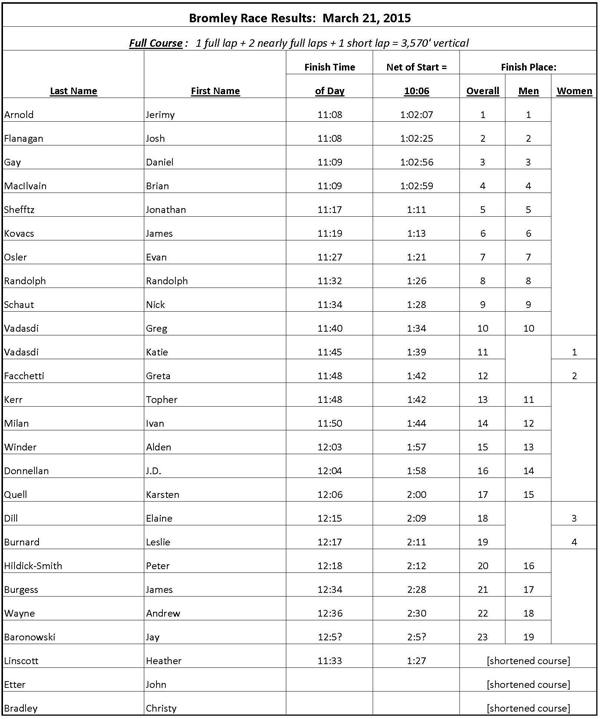
Mad River Valley skimo race
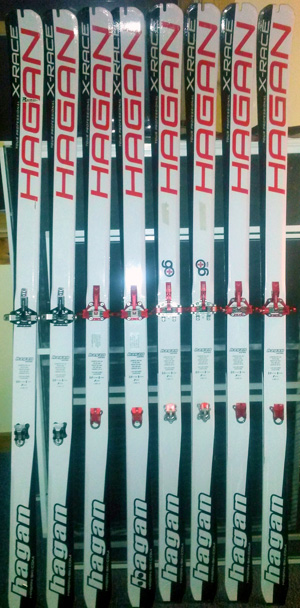
Fortunately, Mad River Glen has started to listen to our input, and hence that part of the course was set up well, including a start line with by far the fastest racers ever in an East Coast race as the Massachusetts and Quebec contingents met up in nearly full force: easily over two dozen with full-on or nearly so race gear, and even two pairs of full-carbon Dynafit RC1 boots.
Unfortunately, after the ascent up Mad River Glen and then past the section of the ridgeline Long Trail traverse where Mad River had partially pruned back the tree branches, we entered a section where Sugarbush’s lack of any trail maintenance was a slap in the face, both literally and figuratively. At least though that eventually added to the post-race banter, i.e., comparing torn packs, clothing, faces, eyeballs, etc.
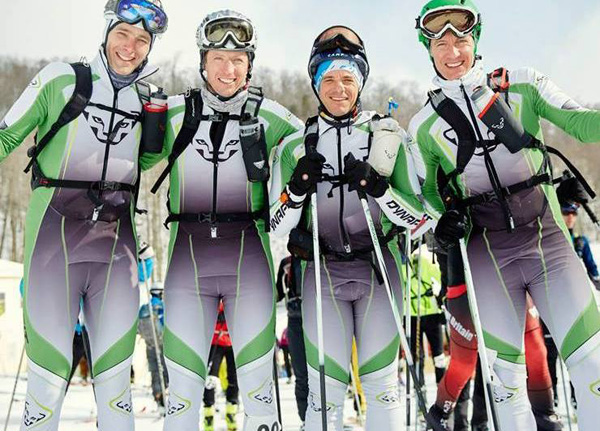
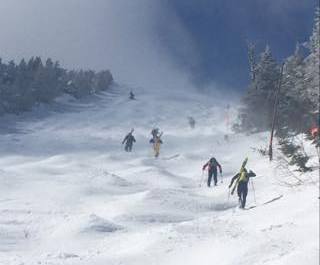 After emerging at Sugarbush’s Mount Ellen, this year we were allowed to bootpack up Upper FIS for a short stretch of a few hundred vertical feet of interesting skiing. But that was it for the entire race: afterwards we cruised down a low-angle groomer to enter a low-angle ungroomed trail, which led us onto even flatter work roads.
After emerging at Sugarbush’s Mount Ellen, this year we were allowed to bootpack up Upper FIS for a short stretch of a few hundred vertical feet of interesting skiing. But that was it for the entire race: afterwards we cruised down a low-angle groomer to enter a low-angle ungroomed trail, which led us onto even flatter work roads.And then worse, as we were subjected to a new loop in the Slidebrook backcountry area between Sugarbush’s separate Mount Ellen and Lincoln Peak areas. When the pre-race briefing on this loop was presented by a woman in telemark boots, I immediately knew that something had to be wrong with this change to the course layout. Fortunately I was far enough back that I could follow the many skintracks without getting lost at the vaguely marked intersections. Then at what seemed like the height of land I deskinned to point ‘em straight down what looked like some pitch … only to immediately throw them sideways for a sharp turn to the left onto the correct (and unmarked) descent. That initial turn was my final for this loop, which was all tucking, often at slow speed. (The previous weekend our five-year-old daughter had skied steeper hills: on edgeless nordic skis.)
Emerging from the Slidebrook backcountry, we were not allowed to skin up to the summit of Sugarbush’s Lincoln Peak, or even to one of its subpeaks as in most prior years. Instead, we had a long skate up a nearly flat beginner trail, and then a long traverse to the finish.
Competitively, Team Hagan was shut out of the podium, although still took three out of the top eight. Equipe Quebec was prevented from yet another Vermont podium sweep – after Burke and Jay – only by former alpine racer and current nordic racer Jan Wellford of the Adirondacks of Northern NY. On the women’s side, former Canadian Olympic cyclist Lyne Bessette probably would have cracked the top ten overall but DNF’ed after a sudden deceleration from her ski tip slamming into some tricky wind slab on Upper FIS triggered a recurrence of her previously dislocated shoulder.
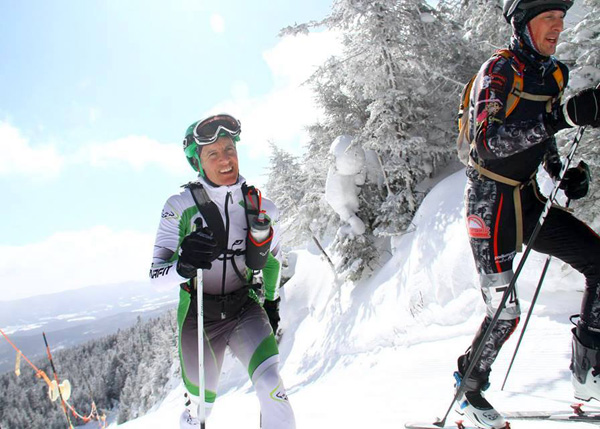
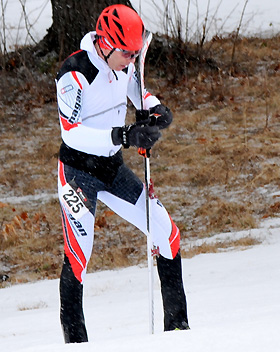
Competitively, Team Hagan members Josh Flanagan and Jerimy Arnold were out with housing-related issues (Colorado hut trip and new home closing, respectively). Brian MacIlvain still took the win for Team Hagan, with Ed Warren closed behind. Team Hagan was denied another podium spot by James Kovacs, who kept lengthening his lead on me with each ascent, while the skiing wasn’t quite tricky enough for me to make it up on the descents as I had done with our first race against each other the prior weekend at Bromley.
Fifth place was an exciting back-and-forth between newcomer Whitney Withington and master’s mountain bike racer Pete Crisci, with Whitney ultimately aided by a wrong turn on the first descent and then an Achilles tear by Pete on the final descent (which left him hobbling in the lodge afterwards).
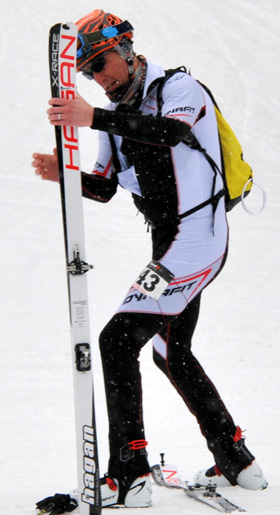
For the last-minute prep award, Ed was the runner-up by stopping at my house the prior night to remount his bindings for new race boots. But Whitney crushed him for the definitive win by texting me on the drive to the race asking if I had an extra set of race skis and skins for her to use with her new boots (tags even still attached in the lodge), which amazingly enough I did.
Looking back on the season as a whole, the growth at the top was unprecedented, especially when both the Massachusetts and Quebec contingents met up with each other: at the Mad River Valley race this year, I was 14th despite *winning* the race in both 2011 and 2012. For the venues in the NE Rando Race Series that I’ve been organizing since 2009, I had never before been shut out of the podium, yet this year that happened in half of the races.
Overall participation in the NE Rando Race Series was also up to 176 starts from last year’s 58, generating almost $8,300 in entry fee revenue for our hosts at the four different venues, i.e., three ski resorts plus a local trail maintenance non-profit. Even netting out the big impact from the Greylock 100-percent backcountry race this season, our starts for the series were still up by over 50 percent from the prior three-year average.
The NE Rando Race Series is very grateful for the support not only of our venue hosts but also the especially generous prize donations from many of our sponsors, most notably Skimo Co, Dynafit, Backcountry Access (continuously since the start of the series in 2009), Off Piste Mag (also since 2009), Toko (ditto), Hammer Nutrition, and Cripple Creek Backcountry, plus Hagan USA for many racer sponsorships.
Looking ahead to next season, we should have the same line-up of venues, plus possibly Bolton Valley in Northern VT for yet another meeting of the full Massachusetts and Quebec contingents.
